- Delicate Clematis for a Stunning Display
- Here are some popular varieties of clematis:
- Exquisite Wisteria for a Touch of Elegance
- Features of Wisteria
- How to Grow Wisteria
- Caution: Invasive Tendencies
- Enchanting Moonflower to Brighten Up Your Nights
- What is a Moonflower?
- How to Grow Moonflowers
- Caring for Moonflowers
- Attracting Pollinators and Wildlife
- Precautions
- Spectacular Trumpet Vine to Attract Hummingbirds
- 1. Description
- 2. Growing Conditions
- 3. Attracting Hummingbirds
- 4. Care and Maintenance
- 5. Other Benefits
- Conclusion
- Beautiful Climbing Rose for a Classic Garden Look
- 1. ‘New Dawn’ (Rosa ‘New Dawn’)
- 2. ‘Zephirine Drouhin’ (Rosa ‘Zephirine Drouhin’)
- 3. ‘Climbing Iceberg’ (Rosa ‘Climbing Iceberg’)
- 4. ‘Joseph’s Coat’ (Rosa ‘Joseph’s Coat’)
- 5. ‘Blaze’ (Rosa ‘Blaze’)
- 6. ‘Don Juan’ (Rosa ‘Don Juan’)
- 7. ‘Golden Showers’ (Rosa ‘Golden Showers’)
- 8. ‘Climbing Peace’ (Rosa ‘Climbing Peace’)
- 9. ‘Lady Banks’ Rose (Rosa banksiae)
- 10. ‘Cécile Brünner’ (Rosa ‘Cécile Brünner’)
- Gorgeous Honeysuckle for a Fragrant Paradise
- Fragrant Blooms
- Colorful Flowers
- Easy to Grow
- Low Maintenance
- Attracts Wildlife
- Versatile Use
- Dazzling Bougainvillea for a Burst of Vibrant Color
- Graceful Jasmine for a Serene and Peaceful Atmosphere
- 1. Arabian Jasmine
- 2. Confederate Jasmine
- 3. Star Jasmine
- 4. Carolina Jasmine
- 5. Pink Jasmine
- 6. Winter Jasmine
- 7. Cape Jasmine
- 8. Chilean Jasmine
- 9. Sweet Autumn Clematis
- 10. Honeysuckle
- Stunning Passion Flower for a Tropical Touch
- 1. Description
- 2. Growing Conditions
- 3. Care and Maintenance
- 4. Uses
- 5. Varieties
- 6. Tips for Growing
- Charming Morning Glory to Welcome the New Day
- 1. Description
- 2. Types
- 3. Growing Conditions
- 4. Care and Maintenance
- 5. Uses
- Questions and Answers:
- What are some popular flowering vines for a garden?
- Which flowering vine is best for attracting butterflies?
- What flowering vine can I grow on a trellis?
- Which flowering vine is best for providing shade?
- How do I care for a flowering vine in my garden?
- Videos: Top 10 Best Flowers for Shaded Areas // PlantDo Home & Garden
Adding flowering vines to your garden is a fantastic way to bring color and beauty to your outdoor space. These climbing plants not only create a stunning visual display, but they also provide shade, privacy, and attract pollinators such as bees and butterflies. Whether you have a trellis, fence, or pergola, there’s a flowering vine that’s perfect for your garden. Here are the top 10 flowering vines that will transform your outdoor space into a vibrant and enchanting oasis.
1. Clematis: Known for its large, showy flowers in a wide range of colors, clematis is a popular choice for gardeners. These climbing plants bloom from early spring to late fall and can be trained to climb trellises, walls, or fences.
2. Wisteria: With its cascading clusters of fragrant, lavender-blue flowers, wisteria is a true showstopper. This vine thrives in full sun and can quickly cover an arbor or pergola, creating a magical tunnel of blooms.
3. Jasmine: Jasmine is prized for its sweet fragrance and delicate white or yellow flowers. Plant it near a seating area or pergola to enjoy its intoxicating scent and adding a touch of romance to your garden.
4. Honeysuckle: Honeysuckle is a classic vine that produces an abundance of trumpet-shaped flowers with a sweet, honey-like fragrance. It’s perfect for attracting hummingbirds and adding a pop of color to fences or walls.
5. Trumpet Vine: As the name suggests, trumpet vine bears vibrant, trumpet-shaped flowers in shades of red, orange, and yellow. This vigorous climber is great for attracting hummingbirds and can cover a trellis or wall in no time.
6. Passionflower: Passionflower is a unique vine with exotic, intricate flowers that come in various colors, ranging from purple to white. The vibrant blooms are followed by tasty fruits, making this vine a favorite among gardeners.
7. Morning Glory: Morning glory is a fast-growing vine with beautiful, funnel-shaped flowers that open in the morning and close in the afternoon. These colorful blooms can quickly cover an unsightly fence or trellis.
8. Climbing Rose: Climbing roses are perfect for adding a touch of elegance and romance to your garden. With their stunning, fragrant flowers in various colors, they can be trained to climb walls, arbors, or pergolas.
9. Bougainvillea: Bougainvillea is a tropical vine that produces vibrant, papery bracts in shades of pink, purple, orange, and red. This showy vine thrives in warm climates and is perfect for adding a splash of color to a patio or garden wall.
10. Virginia Creeper: Virginia creeper is a fast-growing vine with stunning red foliage in the fall. This low-maintenance vine can climb walls or fences, providing beautiful color and texture to your garden throughout the seasons.
Transform your garden into a haven of color and beauty with these top 10 flowering vines. Whether you prefer large showy flowers or delicate blooms with a sweet fragrance, there’s a vine on this list that’s perfect for your garden. From clematis and wisteria to jasmine and honeysuckle, these climbing plants will add charm and character to any outdoor space. So, get ready to enjoy a garden filled with vibrant colors and enchanting scents!
Delicate Clematis for a Stunning Display
Clematis are beautiful, delicate flowering vines that can add a stunning display of color and beauty to any garden. With their graceful blooms and vining habit, clematis can create a vertical accent in your garden and add a touch of elegance to fences, trellises, and arbors.
Here are some popular varieties of clematis:
- Jackmanii: Known for its deep purple flowers, Jackmanii is one of the most popular clematis varieties. This vigorous vine can grow up to 10 feet tall and blooms from late spring to early fall.
- Nelly Moser: With its large, pale pink flowers and a bright pink center stripe, Nelly Moser is a showstopper. This clematis variety blooms from late spring to early fall and can grow up to 12 feet tall.
- Sweet Autumn: Sweet Autumn clematis is a versatile vine that can be planted as a ground cover or trained to climb. It produces masses of small, fragrant white flowers in late summer and early fall.
- Blue Angel: If you’re looking for a blue-flowering clematis, Blue Angel is a great choice. This variety produces large, lavender-blue flowers and can grow up to 8 feet tall.
Clematis look their best when they have something to climb on, so it’s important to provide them with a support structure such as a trellis or an arbor. They also prefer to have their roots cool and shaded, so make sure to plant them in a spot where their base will be in the shade.
These delicate vines are relatively low-maintenance but will benefit from regular pruning in late winter or early spring. Pruning helps to promote new growth and keeps the plant healthy and vigorous.
With their stunning displays of color and their graceful, vining habit, clematis are a wonderful addition to any garden. Whether you choose a traditional purple variety or opt for something more unique like a blue-flowering clematis, these vines will surely bring beauty and elegance to your outdoor space.
Exquisite Wisteria for a Touch of Elegance
Wisteria is a breathtaking flowering vine that adds a touch of elegance to any garden. With its cascading blooms and delicate fragrance, wisteria is a favorite among gardeners and flower enthusiasts. This enchanting plant is known for its vigorous growth and stunning display of purple, pink, or white flowers.
Wisteria comes in two main varieties: Chinese wisteria and Japanese wisteria. Both varieties are equally beautiful and have a similar growth habit. They are deciduous woody vines that can reach impressive lengths and require a sturdy support structure to grow on.
Features of Wisteria
- Cascading Blooms: Wisteria is known for its long, pendulous clusters of flowers that hang down from the branches, creating a mesmerizing effect.
- Fragrance: The flowers of wisteria emit a sweet fragrance that fills the air, making it a popular choice for gardens and outdoor spaces.
- Vigorous Growth: Wisteria vines can grow rapidly, covering an arbor, trellis, or pergola with their lush foliage and blossoms within a few years.
- Color Variety: Wisteria flowers come in different colors, including shades of purple, lavender, pink, and white, allowing for versatile design options in the garden.
How to Grow Wisteria
Wisteria thrives in full sun and well-draining soil. It is recommended to plant wisteria in a location where it can climb and spread freely, as it requires ample space to grow. A strong support structure, such as a sturdy trellis or pergola, is essential to provide the necessary support for the vines.
Pruning is crucial to control the size and shape of wisteria. Regular pruning helps maintain the plant’s vigor and promotes better flowering. It is recommended to prune wisteria in late winter or early spring before the new growth starts.
Caution: Invasive Tendencies
While wisteria is undeniably beautiful, it should be noted that it can be an aggressive grower and has invasive tendencies in some regions. It is important to choose the right variety and control its growth to prevent it from overtaking other plants or structures in the garden.
In conclusion, wisteria is a stunning flowering vine that adds elegance and beauty to any garden. Its cascading blooms, sweet fragrance, and vigorous growth make it a popular choice among gardeners. With proper care and maintenance, wisteria can be a showstopper in your outdoor space, providing years of color and charm.
Enchanting Moonflower to Brighten Up Your Nights
If you’re looking for a flowering vine that brings beauty and a touch of magic to your garden at night, the enchanting moonflower is a perfect choice. With its delicate white blossoms that open in the evening, this vine is sure to captivate anyone who sets eyes on it.
What is a Moonflower?
Moonflower, scientifically known as Ipomoea alba, is a fast-growing perennial vine native to tropical and subtropical regions. It belongs to the same family as morning glories and shares their stunning trumpet-shaped blooms. However, what sets the moonflower apart is its unique blooming time, as it opens its flowers in the evening and stays open until morning.
How to Grow Moonflowers
Moonflowers are relatively easy to grow, and they thrive in full sun to partial shade. Here’s a step-by-step guide to growing these enchanting vines:
- Choose a sunny spot in your garden with well-draining soil.
- Sow the seeds directly into the soil after the last frost date, or start them indoors 4-6 weeks before the last frost date.
- Plant the seeds about ½ inch deep and provide them with a trellis or other support structure as they grow.
- Keep the soil moist but not waterlogged during the growing season.
- Once the vines start flowering, be sure to admire their beauty in the evening when the flowers open.
Caring for Moonflowers
To keep your moonflowers healthy and beautiful, follow these care tips:
- Water the vines regularly, especially during dry spells.
- Apply a balanced fertilizer once a month to promote vigorous growth and abundant blooms.
- Remove any weeds or competing plants around the base of the moonflower vine.
- Prune the vines in early spring to maintain their shape and control their growth.
Attracting Pollinators and Wildlife
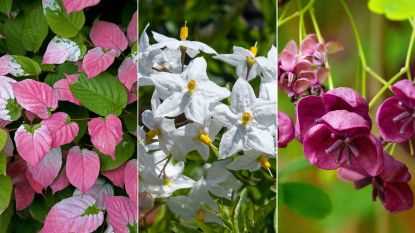
Moonflowers are a favorite of many nocturnal pollinators, such as moths and bats. Their fragrance and white flowers attract these creatures, which help in pollination. Additionally, moonflower vines can provide shelter and nesting sites for small birds and other wildlife, adding to the biodiversity of your garden.
Precautions
It’s important to note that moonflowers are part of the nightshade family, and their seeds and other plant parts are toxic if ingested. Keep children and pets away from the plants, and exercise caution when handling them.
In conclusion, if you’re looking to add a touch of enchantment to your garden and enjoy the beauty of flowers at night, the moonflower is an excellent choice. With its evening blooming schedule and delicate white blossoms, this vine is sure to create a magical ambiance in your outdoor space.
Spectacular Trumpet Vine to Attract Hummingbirds
The trumpet vine (Campsis radicans) is a spectacular flowering vine that is sure to attract hummingbirds to your garden. It is known for its showy orange-red trumpet-shaped flowers and vigorous growth habit.
1. Description

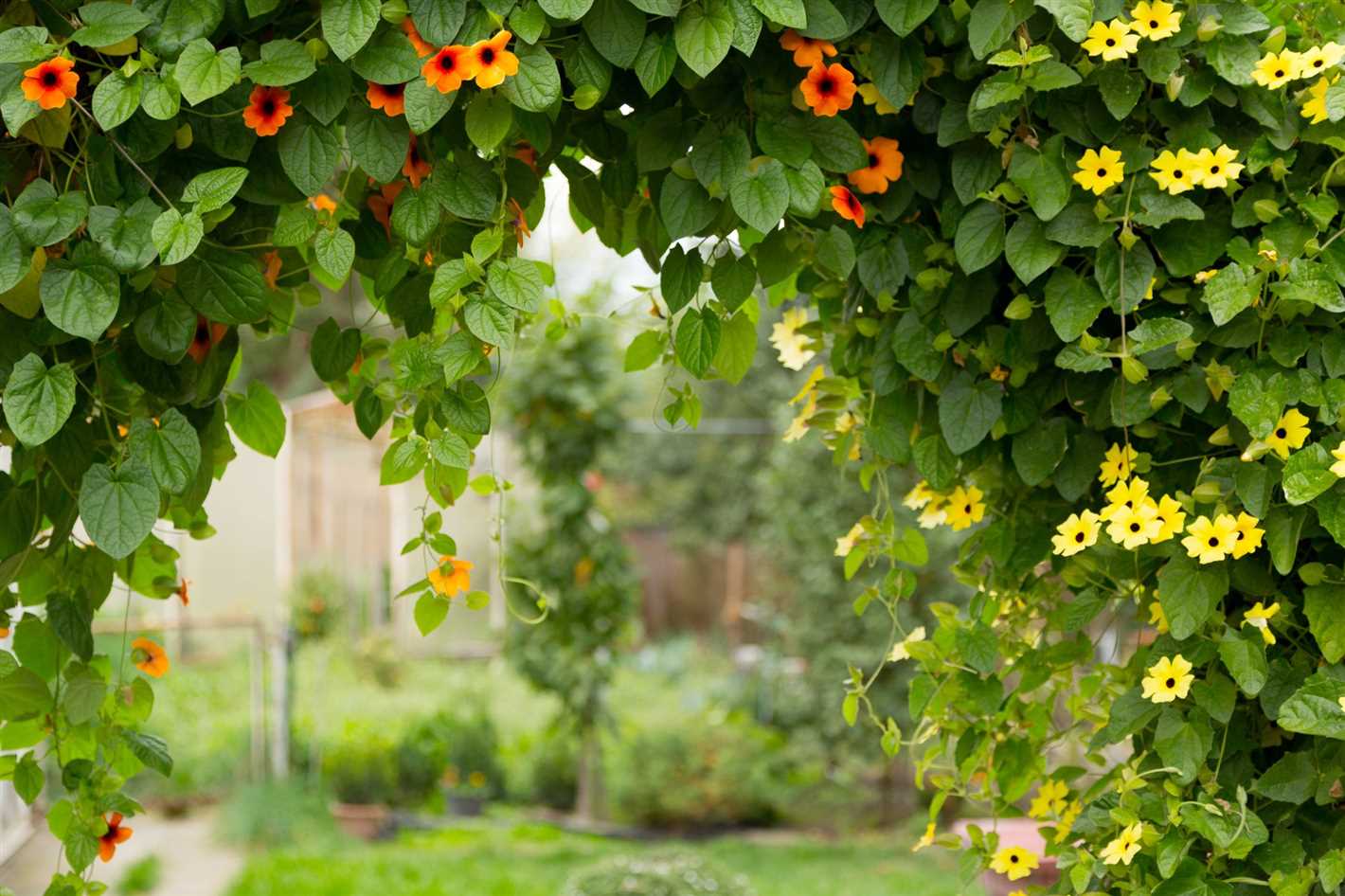
The trumpet vine is a woody vine that can reach heights of 30 to 40 feet or more. Its leaves are pinnate and glossy, providing an attractive backdrop to its vibrant flowers. The trumpet-shaped flowers are typically orange-red, but can also be yellow or salmon in color. They bloom in clusters and can cover the entire vine, creating a stunning display.
2. Growing Conditions
The trumpet vine is native to North America and thrives in warm, sunny climates. It is a hardy plant that can tolerate a wide range of soil conditions, but prefers well-draining soil. It is also drought-tolerant once established, making it a low-maintenance addition to your garden.
3. Attracting Hummingbirds
Hummingbirds are attracted to the trumpet vine because of its brightly colored flowers and abundant nectar. The trumpet-shaped flowers are the perfect shape for hummingbirds to feed from, and the nectar inside provides them with a high-energy food source. By planting trumpet vines in your garden, you can create a haven for hummingbirds and enjoy watching these beautiful creatures up close.
4. Care and Maintenance
The trumpet vine is a fast-growing plant that requires regular pruning to keep it in check. It can become invasive if not properly maintained, so it is important to monitor its growth and remove any suckers or unwanted shoots. Pruning should be done in late winter or early spring, before new growth begins.
5. Other Benefits
In addition to attracting hummingbirds, the trumpet vine also provides shelter for birds and other wildlife. Its dense foliage creates a nesting habitat, and the vine’s woody stems can provide perches for birds to rest on. It can also be used to cover unsightly structures or provide privacy in your garden.
Conclusion
If you want to attract hummingbirds to your garden, the trumpet vine is an excellent choice. Its showy flowers and vigorous growth habit make it a standout in any garden, and its ability to attract hummingbirds will provide endless entertainment and beauty.
Beautiful Climbing Rose for a Classic Garden Look
If you’re looking to add beauty and elegance to your garden, a climbing rose is a perfect choice. With their stunning blooms and graceful vines, climbing roses can transform any space into a classic, romantic retreat. Here are some of the most beautiful climbing rose varieties that will bring a timeless charm to your garden:
1. ‘New Dawn’ (Rosa ‘New Dawn’)
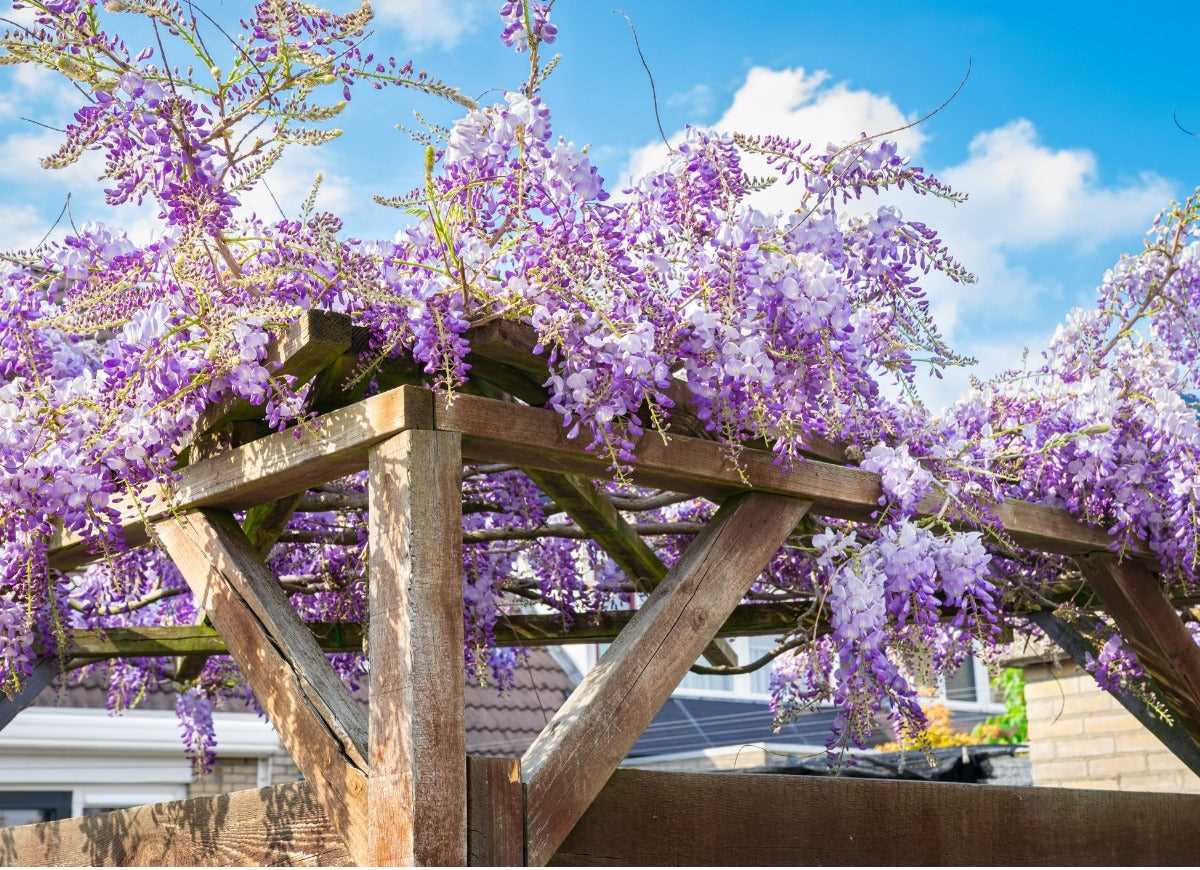
This classic climbing rose features soft pink, fragrant blooms that fade to a creamy white. ‘New Dawn’ is known for its vigorous growth and disease resistance, making it a great choice for beginners.
2. ‘Zephirine Drouhin’ (Rosa ‘Zephirine Drouhin’)
This thornless climbing rose is a favorite among gardeners for its abundant, intensely fragrant blooms. ‘Zephirine Drouhin’ boasts deep pink, semi-double flowers and can thrive in both sunny and shady areas.
3. ‘Climbing Iceberg’ (Rosa ‘Climbing Iceberg’)
If you’re looking for a climbing rose with pure white blooms, ‘Climbing Iceberg’ is a stunning choice. This vigorous rose variety produces clusters of long-lasting, double flowers that have a delightful sweet scent.
4. ‘Joseph’s Coat’ (Rosa ‘Joseph’s Coat’)
With its vibrant, multicolored blooms, ‘Joseph’s Coat’ is sure to make a statement in your garden. This climbing rose has flowers that change color as they age, transitioning from yellow to orange and red.
5. ‘Blaze’ (Rosa ‘Blaze’)
If you’re looking for a classic red climbing rose, ‘Blaze’ is a reliable choice. This vigorous and disease-resistant variety produces clusters of bright red, semi-double blooms that add a pop of color to any garden.
6. ‘Don Juan’ (Rosa ‘Don Juan’)
This deep red climbing rose is known for its strong, spicy fragrance. ‘Don Juan’ produces large, full blooms that are perfect for cutting and bringing inside to enjoy their scent and beauty.
7. ‘Golden Showers’ (Rosa ‘Golden Showers’)
If you prefer yellow roses, ‘Golden Showers’ is a stunning climbing rose variety to consider. This vigorous grower produces bright yellow flowers that have a sweet fragrance and make a beautiful contrast against green foliage.
8. ‘Climbing Peace’ (Rosa ‘Climbing Peace’)
For a touch of peace and serenity in your garden, ‘Climbing Peace’ is an excellent choice. This climbing rose features large, fragrant yellow blooms with pink edges, creating a beautiful combination of colors.
9. ‘Lady Banks’ Rose (Rosa banksiae)
The ‘Lady Banks’ Rose is a thornless climbing rose variety that is known for its profusion of small, delicate, and highly fragrant yellow or white flowers. This rose is perfect for covering walls, fences, or arbors.
10. ‘Cécile Brünner’ (Rosa ‘Cécile Brünner’)
If you’re looking for a climbing rose with small, delicate flowers, ‘Cécile Brünner’ is a great choice. This rose variety has clusters of tiny, fully double blooms in soft pink color that emit a sweet fragrance.
With these beautiful climbing rose varieties, you can create a classic and romantic garden that will be the envy of all your neighbors. Whether you prefer vibrant reds, soft pinks, or sunny yellows, there’s a climbing rose to suit your taste and style. Plant them against a trellis, fence, or wall, and watch as these roses bring color, fragrance, and timeless beauty to your outdoor space.
Gorgeous Honeysuckle for a Fragrant Paradise
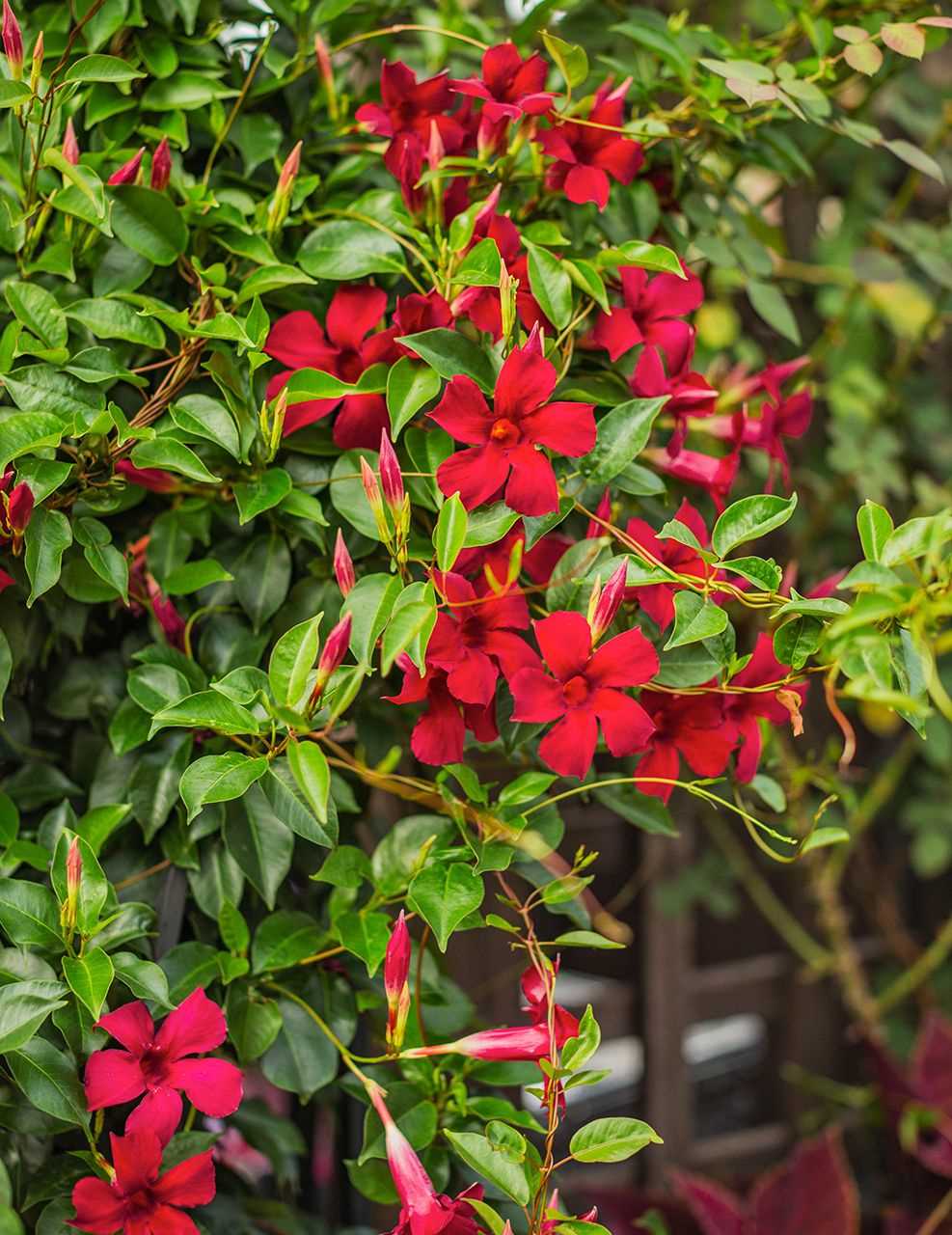
Honeysuckle is a stunning flowering vine that brings both beauty and fragrance to any garden. With its vibrant colors and sweet scent, honeysuckle is a favorite among many gardeners. Here are some of the top reasons why honeysuckle should be a part of your garden:
Fragrant Blooms
One of the main attractions of honeysuckle is its intoxicating fragrance. The sweet scent of honeysuckle blooms fills the air, creating a fragrant paradise in your garden. The aroma is especially strong in the evening, attracting moths and other pollinators.
Colorful Flowers
Honeysuckle vines produce an abundance of colorful flowers that add a pop of color to your garden. The blooms come in various shades, including vibrant red, yellow, orange, and pink. The contrasting colors create a beautiful display and attract hummingbirds and butterflies.
Easy to Grow
Honeysuckle is known for its ability to thrive in different growing conditions. Whether you have a sunny or partially shaded area, honeysuckle will adapt and grow well. It is a fast-growing vine that can reach heights of up to 20 feet, making it perfect for covering fences, walls, or trellises.
Low Maintenance
Once established, honeysuckle requires minimal care. It is drought-tolerant and doesn’t need frequent watering. Pruning is only necessary to control its growth and shape. Honeysuckle is also relatively pest-free, making it a hassle-free addition to your garden.
Attracts Wildlife
Honeysuckle is a magnet for wildlife, attracting hummingbirds, butterflies, and bees to your garden. The nectar-rich flowers provide a valuable food source for these pollinators. Additionally, birds are drawn to honeysuckle berries, creating a wildlife-friendly environment in your backyard.
Versatile Use
Honeysuckle can be used in various ways in your garden. It can be trained to climb on fences or trellises to create a natural privacy screen. You can also let it sprawl along the ground as a ground cover or use it to cascade down from hanging baskets or containers. Honeysuckle also works well in cottage gardens or to add a touch of romance to any outdoor space.
| Variety | Color | Fragrance |
|---|---|---|
| Japanese Honeysuckle | White to yellow | Strong |
| Trumpet Honeysuckle | Red to orange | Moderate |
| Goldflame Honeysuckle | Pink to yellow | Strong |
With its fragrant blooms, vibrant colors, and easy maintenance, honeysuckle is a must-have for any garden. It will not only enhance the visual appeal of your outdoor space but also create a fragrant paradise where you can relax and enjoy the beauty of nature.
Dazzling Bougainvillea for a Burst of Vibrant Color
The vibrant and colorful Bougainvillea is a popular choice for gardeners looking to add a burst of color and beauty to their outdoor space. With its stunning flowers and lush foliage, this flowering vine is sure to make a statement in any garden.
1. Types of Bougainvillea
There are several different types of Bougainvillea, each with its own unique characteristics and colors. Some popular varieties include:
- Bougainvillea spectabilis
- Bougainvillea glabra
- Bougainvillea peruviana
- Bougainvillea arborea
These varieties offer a range of colors, including vibrant shades of pink, purple, red, orange, and yellow.
2. Growing Bougainvillea
Bougainvillea is a relatively easy plant to grow, making it suitable for both experienced gardeners and beginners. It requires full sun and well-drained soil, and it is important to water it regularly, especially during dry periods.
3. Pruning and Training
To keep your Bougainvillea looking its best, regular pruning is recommended. This will help to maintain its shape and encourage new growth. The vines can also be trained along a trellis, fence, or pergola to create an attractive and eye-catching display.
4. Attracting Butterflies and Bees
Bougainvillea flowers are not only beautiful to look at, but they also attract butterflies and bees, making them a great addition to any pollinator-friendly garden. These insects play a crucial role in pollinating plants and helping them thrive.
5. Versatility in the Garden
Bougainvillea can be used in a variety of ways in the garden. It can be grown as a vine, covering a trellis or pergola, or as a shrub or small tree. It can also be planted in containers and placed on patios or balconies to add a pop of color to outdoor living spaces.
6. Low Maintenance
Once established, Bougainvillea is a relatively low-maintenance plant. It is drought-tolerant and doesn’t require frequent watering. It is also resistant to most pests and diseases, making it a hassle-free choice for any garden.
7. Blooming Season
Bougainvillea typically blooms in cycles, producing vibrant flowers throughout the year. While it thrives in warm, tropical climates, certain varieties can also tolerate colder temperatures and still bloom beautifully.
8. Beautiful Accents
The vibrant color and stunning flowers of Bougainvillea make it a perfect choice for adding accents and focal points in the garden. Whether you want to brighten up a fence, create a colorful archway, or add a splash of color to a dull corner, Bougainvillea can do it all.
9. Container Gardening
If you have limited space or want to create a portable display, Bougainvillea can be grown in containers. Make sure the pot has good drainage and choose a compact variety that is suitable for container gardening.
10. Enjoying Bougainvillea
Finally, don’t forget to take the time to sit back and enjoy the beauty of your Bougainvillea. Whether you are admiring it from a distance or taking a closer look at the intricate details of its flowers, this flowering vine is sure to bring joy and vibrant color to your garden.
Graceful Jasmine for a Serene and Peaceful Atmosphere
Jasmine is a beautiful flowering vine that can add a touch of elegance and serenity to any garden. Known for its fragrant blooms and delicate foliage, jasmine is a popular choice among garden enthusiasts.
There are several varieties of jasmine to choose from, each with its own unique characteristics and growing requirements. Whether you’re looking for a vine to cover a trellis or a ground cover to fill in empty spaces, there’s a jasmine variety that will suit your needs.
1. Arabian Jasmine
Arabian jasmine (Jasminum sambac) is a popular choice for its intensely fragrant white flowers. This variety is known for its compact growth habit, making it perfect for small gardens or containers.
2. Confederate Jasmine
Confederate jasmine (Trachelospermum jasminoides) is a vigorous vine that can quickly cover fences or walls. It produces clusters of white, star-shaped flowers that are highly fragrant.
3. Star Jasmine
Star jasmine (Trachelospermum asiaticum) is a versatile vine that can be trained to climb trellises, walls, or even arbors. It features glossy, dark green leaves and produces clusters of white, star-shaped flowers.
4. Carolina Jasmine
Carolina jasmine (Gelsemium sempervirens) is a fast-growing vine that is native to the southeastern United States. It produces yellow, trumpet-shaped flowers and is known for its intense fragrance.
5. Pink Jasmine
Pink jasmine (Jasminum polyanthum) is a twining vine that produces clusters of fragrant pink flowers. It is a popular choice for its rapid growth and ability to cover unsightly structures.
6. Winter Jasmine
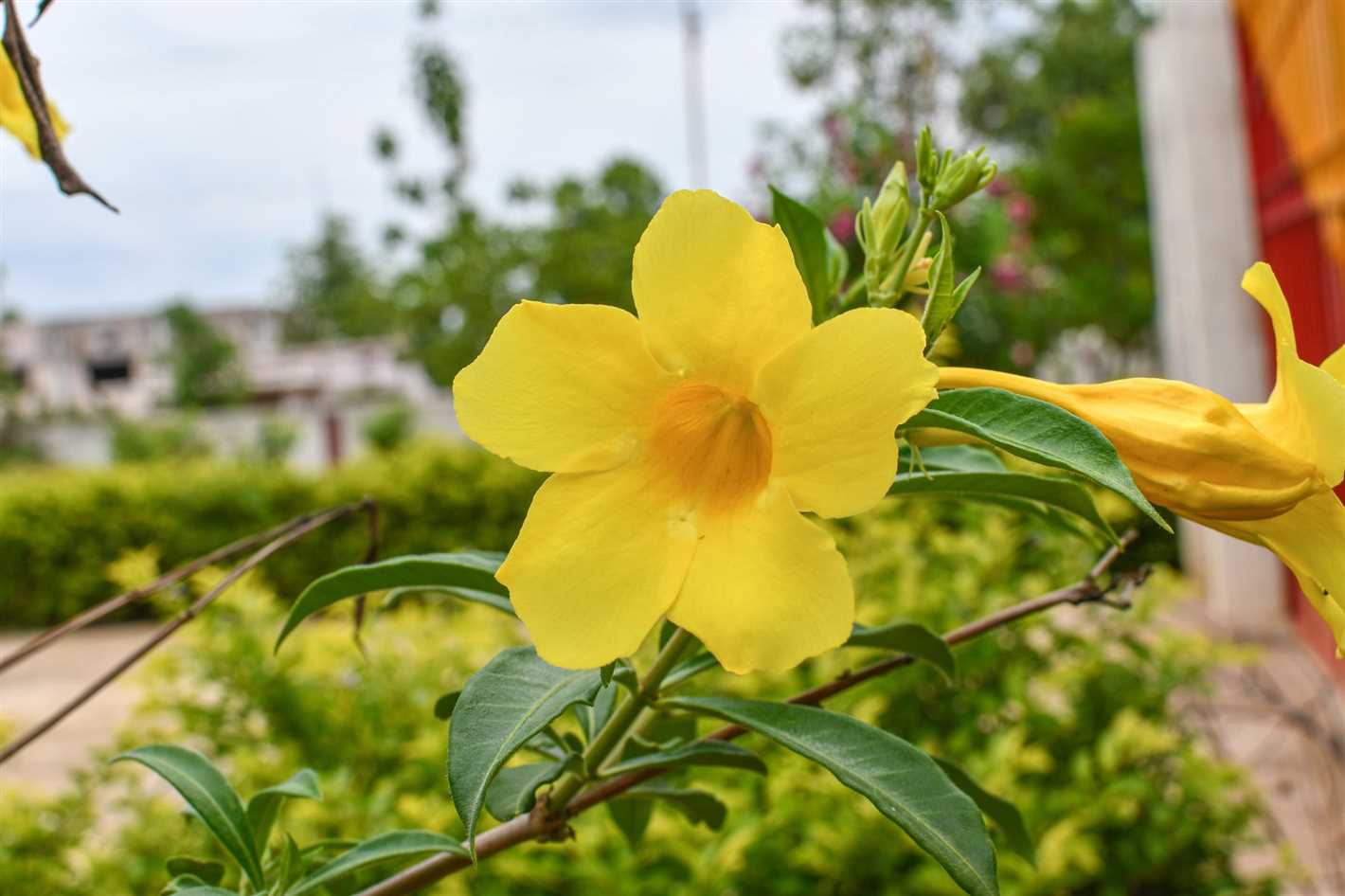
Winter jasmine (Jasminum nudiflorum) is a deciduous vine that blooms in late winter or early spring. It features bright yellow flowers and can be trained to grow along trellises or fences.
7. Cape Jasmine
Cape jasmine (Gardenia jasminoides) is a popular choice for its large, white, heavily fragrant flowers. This vine can be trained to climb fences or walls, or grown as a shrub.
8. Chilean Jasmine
Chilean jasmine (Mandevilla laxa) is a vigorous vine that produces clusters of fragrant, white flowers. It is native to Chile and can be trained to climb trellises, pergolas, or fences.
9. Sweet Autumn Clematis
Sweet autumn clematis (Clematis terniflora) is a fast-growing vine that produces clusters of small, white flowers in late summer or early autumn. It is known for its sweet fragrance and ability to attract butterflies.
10. Honeysuckle
Honeysuckle (Lonicera spp.) is a popular choice for its beautiful, fragrant flowers and ability to attract hummingbirds. There are several varieties of honeysuckle to choose from, each with its own unique characteristics.
Whichever variety of jasmine you choose to plant in your garden, you can be sure that it will add beauty, fragrance, and a peaceful atmosphere to your outdoor space. Whether you’re looking to create a serene retreat or simply add a touch of elegance to your garden, jasmine is a perfect choice.
Stunning Passion Flower for a Tropical Touch
The passion flower is a beautiful flowering vine that adds a touch of tropical beauty to any garden. Known for its intricate and colorful blooms, the passion flower is sure to captivate the attention of anyone who sees it.
1. Description
The passion flower, or Passiflora, is a genus of flowering plants that belong to the family Passifloraceae. It includes around 550 species, most of which are vines with showy and unique flowers. The flowers of the passion flower are typically large, about 3-4 inches in diameter, and they come in a variety of colors, including purple, red, blue, and white.
2. Growing Conditions
Passion flowers are native to tropical and subtropical regions, so they thrive in warm climates. They prefer full sun but can tolerate some shade. The soil should be well-draining and rich in organic matter. These plants also need a trellis or support structure to climb on.
3. Care and Maintenance
Passion flowers are relatively easy to care for, but they do require some attention. Regular watering is important, especially during dry spells. It’s also recommended to fertilize the plants every month during the growing season. Pruning is necessary to control the growth and shape of the vine.
4. Uses
The passion flower vine is not only grown for its beauty but also for its fruit. The passion fruit is edible and can be used in a variety of dishes, drinks, and desserts. Additionally, passion flowers are known to attract butterflies, bees, and hummingbirds, making them an excellent choice for attracting wildlife to your garden.
5. Varieties
There are several popular varieties of passion flowers, each with their own unique features. Some popular varieties include Passiflora incarnata (purple passion flower), Passiflora edulis (common passion fruit), and Passiflora caerulea (blue passion flower).
| Variety | Color | Notable Features |
|---|---|---|
| Passiflora incarnata | Purple | Fragrant flowers |
| Passiflora edulis | Purple | Edible fruit |
| Passiflora caerulea | Blue and white | Tolerates colder climates |
6. Tips for Growing
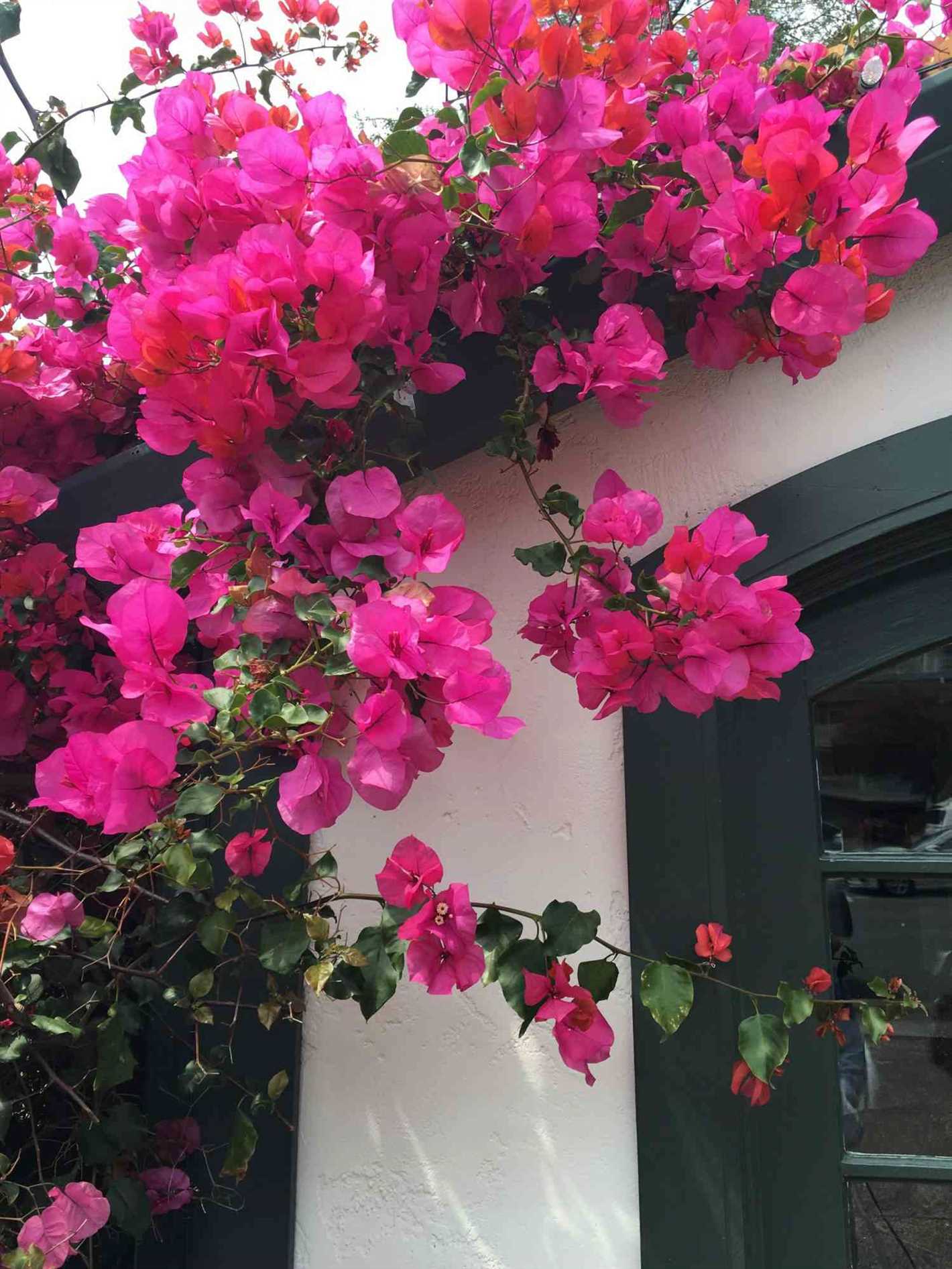
- Plant passion flowers in a sunny location with well-draining soil.
- Provide a trellis or support structure for the vine to climb on.
- Water regularly, especially during dry spells.
- Fertilize monthly during the growing season.
- Prune to control the growth and shape of the vine.
With their stunning flowers and tropical appeal, passion flowers are a must-have for any garden. Whether you grow them for their beauty or their delicious fruit, these vines are sure to impress.
Charming Morning Glory to Welcome the New Day
Morning Glory is a charming flowering vine that blooms in beautiful shades of blue, purple, pink, and white. Its vibrant colors and delicate blooms make it a perfect addition to any garden.
1. Description
Morning Glory, known scientifically as Ipomoea, is a fast-growing vine that can reach heights of up to 15 feet. It has heart-shaped leaves and produces trumpet-shaped flowers that open in the morning and close in the afternoon, hence its name. The flowers attract butterflies, bees, and hummingbirds, adding even more beauty to your garden.
2. Types

There are many different types of Morning Glory, each with its own unique characteristics. Some popular varieties include:
- Heavenly Blue: This variety has large, sky-blue flowers that create a stunning display.
- Scarlett O’Hara: With its deep red blooms, this variety is sure to make a bold statement in your garden.
- Cypress Vine: Known for its fern-like foliage and delicate red, pink, or white flowers, this variety adds a touch of elegance to any garden.
3. Growing Conditions
Morning Glory is a versatile plant that can thrive in most soil types, but it prefers well-drained soil. It requires full sun to bloom abundantly, so make sure to choose a sunny spot in your garden. The vine can be grown from seeds or young transplants. Simply sow the seeds or plant the transplants in the spring after the danger of frost has passed, and they will start to grow quickly.
4. Care and Maintenance
Morning Glory is a low-maintenance plant that requires minimal care. Regular watering and occasional fertilization are usually enough to keep the vine healthy and blooming. However, Morning Glory can be an aggressive grower, so make sure to keep it under control by trimming or pruning as needed.
5. Uses
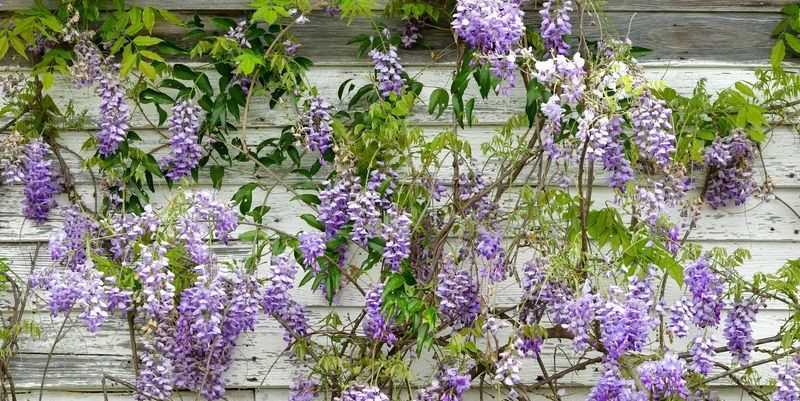
Morning Glory is often grown on trellises, fences, or arbors, creating a stunning vertical display of colors in your garden. It can also be used to provide shade for pergolas or to cover unsightly walls or structures. The vine’s lovely flowers and attractive foliage make it a popular choice for adding beauty and charm to any outdoor space.
Questions and Answers:
What are some popular flowering vines for a garden?
Some popular flowering vines for a garden include clematis, morning glory, honeysuckle, wisteria, and jasmine.
Which flowering vine is best for attracting butterflies?
The butterfly pea vine is known for attracting butterflies, as well as hummingbirds, with its bright blue flowers.
What flowering vine can I grow on a trellis?
There are many flowering vines that can be grown on a trellis, but some popular choices include climbing roses, bougainvillea, and passionflower.
Which flowering vine is best for providing shade?
The trumpet vine is a fast-growing vine that is known for its ability to provide shade due to its dense foliage and large trumpet-shaped flowers.
How do I care for a flowering vine in my garden?
Caring for a flowering vine in your garden typically involves providing adequate support for the vine to climb, regular watering, and pruning to maintain its shape and promote new growth.







